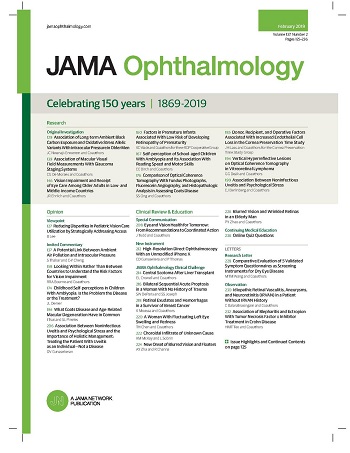玻璃体内抗vegf药物在家庭储存过程中的温度偏移
IF 7.8
1区 医学
Q1 OPHTHALMOLOGY
引用次数: 0
摘要
世界各地的一些患者被要求从药店购买抗血管内皮生长因子(anti-VEGF)药物,储存起来,然后带到医生那里进行玻璃体内注射(IVT)。抗vegf药物必须保存在冰箱中,以避免细菌污染或变性。一些严重的眼内炎症的病例已经报道,在IVT后,最近批准的抗vegf药物,这可能是热不稳定的解释。目的了解患者在日常临床应用中是否遵循玻璃体内抗vegf药物的存放温度指南。设计、环境和参与者:这项质量改进研究于2024年5月27日至6月7日在法国第戎大学医院眼科进行,纳入了所有连续服用玻璃体内抗vegf药物治疗黄斑疾病的患者。所有受试者均获得时间-温度指示器,该指示器根据8°C以上的短暂(2-12小时)、中度(12-48小时)和长时间(≥48小时)暴露而改变颜色。该指标在社区药房向参与者递送抗vegf药物时被激活。结果在研究期间,50名参与者被给予玻璃体内抗vegf药物,并给予时间-温度指标。共38例受试者,其中女性24例[63.2%];中位年龄为79.3 [IQR, 74.3-86.3]岁),有可分析指标返回进行IVT。在38个可分析指标中,所有指标均显示温度偏差高于8℃阈值,其中26个(68.4%)持续12 ~ 48小时,11个(28.9%)持续48小时或更长时间。在使用抗vegf药物IVT后,没有参与者出现任何可能与严重眼内炎症相关的眼部不良反应。在这项质量改善研究中,28.9%的参与者在家庭储存期间记录了抗vegf药物在8°C以上48小时或更长时间的温度偏差。虽然尚不清楚这38名参与者与世界上其他需要获得自己的抗vegf药物的患者有何关系,但这些发现表明,患者需要了解严格维持其抗vegf药物冷藏的重要性。本文章由计算机程序翻译,如有差异,请以英文原文为准。
Temperature Excursion of Intravitreal Anti-VEGF Agents During Home Storage
ImportanceSome patients worldwide are asked to acquire an anti–vascular endothelial growth factor (anti-VEGF) agent from a pharmacy, store it, and then bring it to a physician for intravitreal injection (IVT). Anti-VEGF agents must be stored in the refrigerator to avoid bacterial contamination or denaturation. Some cases of severe intraocular inflammation have been reported following IVT of more recently approved anti-VEGF agents, which might be explained by thermal instability.ObjectiveTo investigate whether patients followed the storage temperature guidelines for intravitreal anti-VEGF agents in daily clinical practice.Design, Setting, and ParticipantsThis quality improvement study, performed between May 27 and June 7, 2024, at the Ophthalmology Department of Dijon University Hospital in Dijon, France, included all consecutive patients with new or renewed prescriptions for intravitreal anti-VEGF agents for any macular disease.Main Outcomes and MeasuresAll participants were given a time-temperature indicator that changed color according to brief (2-12 hours), moderate (12-48 hours), and prolonged (≥48 hours) exposure over 8 °C. The indicator was activated at the time of the anti-VEGF agent delivery to the participant in community pharmacies.ResultsDuring the study period, 50 participants were prescribed intravitreal anti-VEGF agents and were given a time-temperature indicator. A total of 38 participants (24 [63.2%] female; median age, 79.3 [IQR, 74.3-86.3] years) returned for their IVT with an analyzable indicator. Of the 38 analyzable indicators, all showed temperature excursions above the threshold of 8 °C, including 26 (68.4%) for 12 to 48 hours and 11 (28.9%) for 48 hours or longer. Following anti-VEGF agent IVT, no participant experienced any ocular adverse effect that might be associated with severe intraocular inflammation.Conclusions and RelevanceIn this quality improvement study, temperature excursions of anti-VEGF agents above 8 °C for 48 hours or longer were recorded for 28.9% of participants during home storage. While it is unknown how these 38 participants relate to other patients worldwide who are required to obtain their own anti-VEGF agents, these findings suggest that patients need education about the importance of rigorous maintenance of cold storage of their anti-VEGF agents.
求助全文
通过发布文献求助,成功后即可免费获取论文全文。
去求助
来源期刊

JAMA ophthalmology
OPHTHALMOLOGY-
CiteScore
13.20
自引率
3.70%
发文量
340
期刊介绍:
JAMA Ophthalmology, with a rich history of continuous publication since 1869, stands as a distinguished international, peer-reviewed journal dedicated to ophthalmology and visual science. In 2019, the journal proudly commemorated 150 years of uninterrupted service to the field. As a member of the esteemed JAMA Network, a consortium renowned for its peer-reviewed general medical and specialty publications, JAMA Ophthalmology upholds the highest standards of excellence in disseminating cutting-edge research and insights. Join us in celebrating our legacy and advancing the frontiers of ophthalmology and visual science.
 求助内容:
求助内容: 应助结果提醒方式:
应助结果提醒方式:


